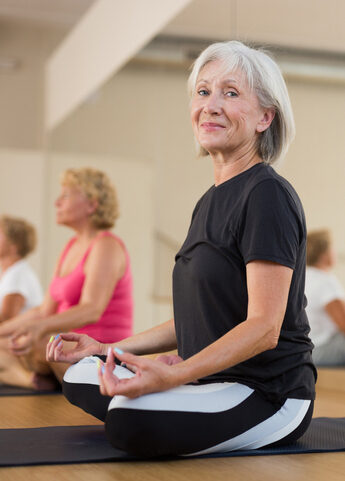Exercise and Aging

Move more, live better
As we get older, we all start to slow down. It’s inevitable. And it becomes all-to-easy to find excuses to not exercise. We tell ourselves that we’re too busy, too tired, too stressed, or simply just too old to bother. But the truth is staying active is essential for a healthy life, especially as you grow older..
“A lot of the symptoms that we associate with old age, such as weakness and loss of balance, are actually symptoms of inactivity, not age.”
Dr. Alicia Arbaje
Dr. Arbaje, an assistant professor of Geriatrics and Gerontology at Johns Hopkins University School of Medicine, says exercise is almost like a silver bullet for lots of health problems. “For many people exercise can do as much, if not more good, than the five to 10 medications they take every day.”
8 Benefits of Exercise for the Elderly
If you think that ‘working out’ is only for younger people, you may want to think again. A comprehensive 2019 study found that even a small increase in physical activity lowered seniors’ risk of getting heart disease by 11%. On the other hand, stopping physical activity increased the risk of heart disease by 27%.
The best part? Age is no obstacle. A study of resistance exercise and the elderly found that even people in their 80s and 90s — who hadn’t weight trained before — showed significant gains after starting a supervised program of lifting weights three times a week.
And, as if that’s not enough, a study by the World Health Organization found regular physical activity can potentially add three to four years to your life.
Of course if you’re of a certain age you should always check with a healthcare professional before starting any exercise program.
That said, let’s take a quick look at eight of the biggest exercise benefits for the elderly.
1. Improved mood and mental health
Regular exercise not only brings about physical benefits, but it can also make us feel better. This holds particularly true for the elderly, who through the natural course of aging are more susceptible to depression, anxiety, and dementia.
Exercise is often referred to as “nature’s stress reliever.” When you exercise, your body releases feel-good hormones called endorphins that act as natural painkillers and mood boosters.
Recent studies have found that even short bursts of exercise, as brief as two minutes a day, can have a positive impact on our overall health.
2. Improved sleep quality
Regular exercise has been shown to significantly enhance the sleep quality of older adults. Research indicates that consistent physical activity can assist the elderly in falling asleep more easily, enjoying longer periods of uninterrupted sleep, and experiencing a more refreshing rest.
In fact, a recent study conducted by the Journal of Sleep Research revealed that older individuals who engaged in regular exercise reported significant improvements in their sleep quality, along with reduced levels of daytime fatigue and insomnia.
And again, it doesn’t take long to feel a difference. Researchers say just four weeks of consistent exercise helped chronic insomniacs fall asleep 13 minutes faster and stay asleep for an additional 18 minutes.
3. Reduced risk of falls
Did you know that 1 in 4 older adults experiences a fall each year? It’s the leading cause of injuries for people ages 65 and older. Falls are also the most common cause of hip fractures and traumatic brain injuries.
But there are things you can do to greatly reduce this risk. Regular exercise improves balance, coordination, and flexibility, making falls less likely.
A study published in the National Library of Medicine found that 73% of older adults who exercised at least 3 times a week for 40 minutes saw significant improvements in mobility, flexibility, and balance within just 12 weeks.
Not only that, staying active helps you recover faster if you do fall. Exercise strengthens muscles and bones, aiding in a quicker recovery.
4. Improved cardiovascular health
If you’re looking for a way to keep your heart healthy and strong, regular aerobic exercise is a good way to go.
Working out elevates your heart rate, which promotes efficient blood circulation from head to toe. This improved blood flow helps keep your arteries clear and prevents the build-up of plaque that leads to heart disease.
Regular aerobic exercise can significantly reduce the risk of developing coronary artery disease, congestive heart failure, or stroke by up to 62%.
It can also help control weight and reduce the chances of developing other conditions that can strain the heart, such as high blood pressure, high cholesterol, and type 2 diabetes.
5. Enhanced disease resistance
Still looking for yet another reason to break a sweat? Well, exercise might just hold the key to keeping you healthy and away from the doctor’s office.
Extensive research has demonstrated that regular physical activity can significantly boost your immune system, offering crucial protection against chronic conditions like heart disease, stroke, cancer, and diabetes, particularly in older individuals.
Not only does exercise improve blood circulation, but it also helps in reducing stress levels and inflammation. Moderate exercise has also enhances the function of white blood cells, the superheroes of our body responsible for fighting off infections.
6. Greater muscle mass
A regular strength-training program can be a game-changer for older adults, especially when it comes to getting stronger and building muscles.
As we age, our muscle mass decreases at surprising rates. We can lose up to 40% of our muscle mass by the time we reach 80.
But this age-related loss of muscle can be reversed. Weight training can actually build new muscle. Research has found the greater the intensity of weight-lifting programs, the more dramatic the outcomes. Seniors who lifted the most weight boosted their upper and lower body strength by nearly a third.
Muscle strength and balance also help prevent falls, one of the most common reasons seniors end up in the hospital.
Getting our strength back in our golden years takes work, dedication, and a plan, but it is never too late to rebuild muscle and maintain it.
7. Build bone-strength back
As we age, our bones become thinner and more fragile, making them more prone to fractures. However, there is something we can do about bone loss. Research shows strength and resistance training can slow down bone loss and even build new bone.
While bones might seem solid, they actually have tiny holes like a honeycomb inside. Bone tissues are broken down and rebuilt all the time. But as we get older, we start to lose more bone than we rebuild. If this loss of bone density goes too far, known as osteoporosis, has serious health consequences.
Weight training exercises can help reduce the risk of osteoporosis by increasing bone density. Strength training, in particular, targets bone. When bones are stressed during weight training, the body breaks down old bone tissue and creates new tissue, which makes bones stronger and denser. Additionally, resistance workouts that focus on power and balance improve strength and stability, boosting confidence and reducing the risk of falls and fractures.
8. Boost brain function
The sure and sorry fact is that our mental agility starts to falter as we grow older. These so-called “senior moments”, instances where we can’t remember names or find our parked car, start in middle age and get worse from there.
This natural decline is a result of our brain’s structure and function weakening over time. Neurons deteriorate and the connections between them eventually begin to wither. But that doesn’t mean you have to just sit there and take it.
A study published in Alzheimer’s & Dementia in 2022 found that older adults who exercise regularly produce higher levels of brain proteins which protect and enhance neuronal connections. A study in Alzheimer’s & Dementia found that older adults who exercise regularly have higher levels of brain proteins that protect and enhance neuronal connections. After only four months of exercise, brain scans showed stronger connections, with cells and networks lighting up simultaneously, indicating improved cognitive function.
And once again, research shows that it’s never too late to start. A study of sedentary individuals in their 70s and 80s, some of whom had already experienced cognitive decline, showed improvements in brain function after starting an exercise routine. As the study he participants continued to reap the brain benefits of exercise well into old age.
You don’t have to be a gym rat either. Even small doeses of exercise provided real benefits. Which suggests that a little bit can quickly add up to a lot when it comes to good brain health.
Secrets of the Blue Zones
What if most of what we think about why some people live longer than others is wrong?
Blue Zones author Dan Buettner has spent his life working and trying to understand longevity. Here’s a trailer from his Netflix documentary, where he travels around the world to five unique communities where people live extraordinarily long and healthy lives.
Tips for getting started!
1. Talk to your doctor
Most adults over the age of 65 can exercise safely, even those with health conditions and mobility challenges. But the first thing you need to do is talk with your doctor to learn which options are right for you.
2. Start out slow
Be careful not to overdo it when first starting out. Start slow and work your way up. You don’t want to risk injury. The most important thing is to keep moving forward. Remember that the goal is progress, not perfection.
3. Set realistic goals
When you start setting health goals, make sure they’re realistic. If you set your goals too high, you’ll likely get discouraged and give up.
4. Find something you enjoy
If you find some fun exercises that you like, you’ll be much more likely to stick with it.
5. Join a class
Working out with others can make your workout more fun and motivating. It’s also a good way to stay accountable.


Let’s Start a Conversation!
At Senior Day KC, we believe in the power of conversation. Reach out to us by calling or texting 660-GOOD DAY (660-466-3329) or emailing [email protected] to find out more.
